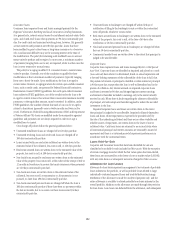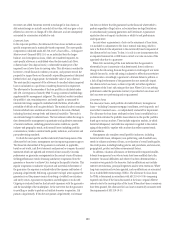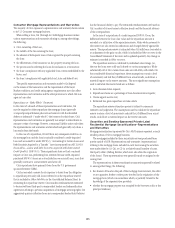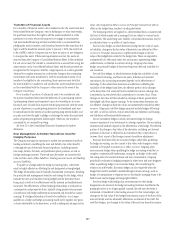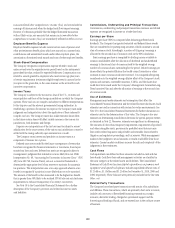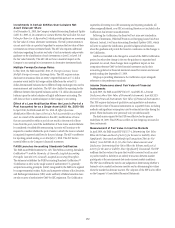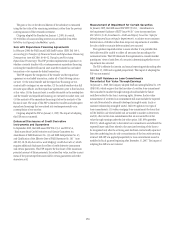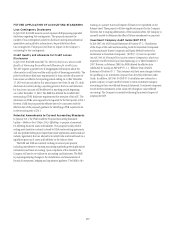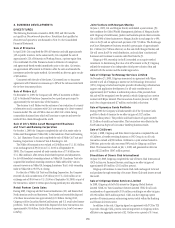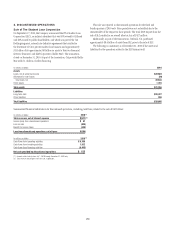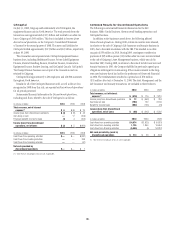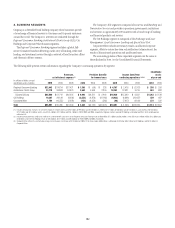Citibank 2010 Annual Report Download - page 174
Download and view the complete annual report
Please find page 174 of the 2010 Citibank annual report below. You can navigate through the pages in the report by either clicking on the pages listed below, or by using the keyword search tool below to find specific information within the annual report.172
Investments in Certain Entities that Calculate Net
Asset Value per Share
As of December 31, 2009, the Company adopted Accounting Standards Update
(ASU) No. 2009-12, Investments in Certain Entities that Calculate Net Asset
Value per Share (or its Equivalent), which provides guidance on measuring
the fair value of certain alternative investments. The ASU permits entities to
use net asset value as a practical expedient to measure the fair value of their
investments in certain investment funds. The ASU also requires additional
disclosures regarding the nature and risks of such investments and provides
guidance on the classification of such investments as Level 2 or Level 3 of
the fair value hierarchy. This ASU did not have a material impact on the
Company’s accounting for its investments in alternative investment funds.
Multiple Foreign Exchange Rates
In May 2010, the FASB issued ASU 2010-19, Foreign Currency Issues:
Multiple Foreign Currency Exchange Rates. The ASU requires certain
disclosure in situations when an entity’s reported balances in U.S. dollar
monetary assets held by its foreign entities differ from the actual U.S.
dollar-denominated balances due to different foreign exchange rates used in
remeasurement and translation. The ASU also clarifies the reporting for the
difference between the reported balances and the U.S. dollar-denominated
balances upon the initial adoption of highly inflationary accounting. The
ASU does not have a material impact on the Company’s accounting.
Effect of a Loan Modification When the Loan Is Part of a
Pool Accounted for as a Single Asset (ASU No. 2010-18)
In April 2010, the FASB issued ASU No. 2010-18, Effect of a Loan
Modification When the Loan is Part of a Pool Accounted for as a Single
Asset. As a result of the amendments in this ASU, modifications of loans
that are accounted for within a pool do not result in the removal of those
loans from the pool, even if the modification of those loans would otherwise
be considered a troubled debt restructuring. An entity will continue to be
required to consider whether the pool of assets in which the loan is included
is impaired if expected cash flows for the pool change. The ASU was effective
for reporting periods ending on or after July 15, 2010. The ASU had no
material effect on the Company’s financial statements.
FASB Launches Accounting Standards Codification
The FASB issued FASB Statement No. 168, The FASB Accounting Standards
Codification™ and the Hierarchy of Generally Accepted Accounting
Principles (now ASC 105, Generally Accepted Accounting Principles).
The statement establishes the FASB Accounting Standards Codification™
(Codification or ASC) as the single source of authoritative U.S. generally
accepted accounting principles (GAAP) recognized by the FASB to be applied
by nongovernmental entities. Rules and interpretive releases of the Securities
and Exchange Commission (SEC) under authority of federal securities laws
are also sources of authoritative GAAP for SEC registrants. The Codification
supersedes all existing non-SEC accounting and reporting standards. All
other nongrandfathered, non-SEC accounting literature not included in the
Codification has become nonauthoritative.
Following the Codification, the Board will not issue new standards in
the form of Statements, FASB Staff Positions or Emerging Issues Task Force
Abstracts. Instead, it will issue Accounting Standards Updates (ASU), which
will serve to update the Codification, provide background information
about the guidance and provide the basis for conclusions on the changes to
the Codification.
GAAP is not intended to be changed as a result of the FASB’s Codification
project, but what does change is the way the guidance is organized and
presented. As a result, these changes have a significant impact on how
companies reference GAAP in their financial statements and in their
accounting policies for financial statements issued for interim and annual
periods ending after September 15, 2009.
Citigroup is providing references to the Codification topics alongside
references to the predecessor standards.
Interim Disclosures about Fair Value of Financial
Instruments
In April 2009, the FASB issued FSP FAS 107-1 and APB 28-1, Interim
Disclosures about Fair Value of Financial Instruments, (now ASC 825-
10-50-10, Financial Instruments: Fair Value of Financial Instruments).
This FSP requires disclosure of qualitative and quantitative information
about the fair value of financial instruments on a quarterly basis, including
methods and significant assumptions used to estimate fair value during the
period. These disclosures were previously only provided annually.
The disclosures required by this FSP were effective for the quarter
ended June 30, 2009. This FSP has no effect on how Citigroup accounts for
these instruments.
Measurement of Fair Value in Inactive Markets
In April 2009, the FASB issued FSP FAS 157-4, Determining Fair Value
When the Volume and Level of Activity for the Asset or Liability Have
Significantly Decreased and Identifying Transactions That Are Not
Orderly (now ASC 820-10-35-51A, Fair Value Measurements and
Disclosures: Determining Fair Value When the Volume and Level of
Activity for the Asset or Liability Have Significantly Decreased). The FSP
reaffirms that fair value is the price that would be received to sell an asset
or paid to transfer a liability in an orderly transaction between market
participants at the measurement date under current market conditions.
The FSP also reaffirms the need to use judgment in determining whether a
formerly active market has become inactive and in determining fair values
when the market has become inactive. The adoption of the FSP had no effect
on the Company’s Consolidated Financial Statements.


